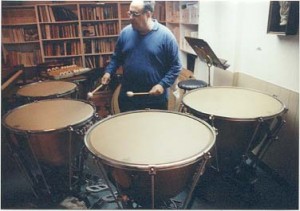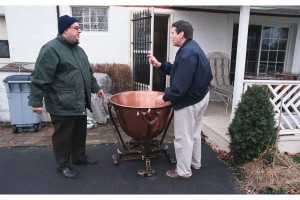My Instruments – Part One
Over the course of my musical life, I have used many different types of timpani. Most of these have been of the pedal-tuned type, but I have had some experience with the hand-tuned as well as cable or chained tuned timpani as well. For the purposes of this post (and the one following ), I will discuss the instruments that I am currently using, saving for later posts discussion of the instruments that I have used in the past.
Primary Instruments
I have the good fortune to have access to two fine sets of instruments for use in my orchestral work. Prior to 1998, I was spoiled. I used the instruments owned by the orchestra in which I was employed – the Oslo Philharmonic. Other than maintaining them, ordering new heads, and in some cases new instruments, the orchestra was responsible for the storage and stage placement of the instruments.
When I returned to the USA, all that changed. I had come back to the free-lance pool – and that meant hauling your own instruments. (I’ll relate this story in a later post.) After I had been back in the USA for a few years, and after I had procured a van and a set of Yamaha timpani, my timpani stick manufacturer and friend, Ron Carlisle told me that he was selling a set of American Drum Company Mark XI Dresden-style timpani
which he had had for several years but needed to sell. I immediately expressed interest in them, and after consulting with my good friend and fellow percussionist Jim Holland, we decided to go down to Carnegie, PA and meet with Ron and check out the drums. This was in February 2002. While free-lancing at this time, I was employed part time as an IT specialist for Jim’s company, Moore-Addison Co. of Addison, IL. Jim and I took the company van and drove to Carnegie, PA. After settling in at our motel, we drove over to Ron’s home and checked out the instruments.
They were, as I have stated, a set of Mark XIs – sizes 23″, 26″, 29″ and 31″ and were in excellent shape. They were equipped with Remo Renaissance hazy heads (gold colored) and have the apple shaped kettles which I prefer. The sound is warm and blends well. That evening, Jim and I tested the drums for several hours, then made our decision based on the condition of the instruments. Getting them back to Illinois in the van would not be a problem, as the company van was more than large enough to accommodate all four drums – and then some. What was to prove a challenge was to get the 31 inch drum out of the studio as the doors were too narrow for it to pass through.
The Move
Ron Carlisle is a pretty resourceful chap, and had the solution to hand. It was his practice to partially disassemble the 31 inch drum – take of the rods, counter hoop and head, and pass the drum through the door opening sideways, then reassemble the instrument outside on the driveway/patio.
As you can see by the photos, this was a relatively easy procedure, but we were hampered just a bit by the fact that it was a rather cool February morning with a bit of a breeze. Luckily, we were not hampered by any snow.
With Ron directing us, we accomplished the whole procedure – from disassembly, move and reassembly and loading into the van in about ten minutes. The other three drums were already sitting pretty in the van, and we were soon off on our merry way back to Illinois.
The Mark XIs
The Mark XI timpani – designed and built by the American Drum Manufacturing Company of Denver, Colorado – are what I call a mid-range Dresden-style set of timpani. The company (unfortunately forced out of business in 2015 due to issues with their location) manufactured three lines of Dresden timpani – the top-of-the line Mark XIV; the mid-range Mark XI; and the tough and sturdy “economy” model – the Metropolitan B. The Light timpani were as a rule excellent instruments. The drums we bought from Ron date from the late 1970s and early 1980s. I believe the 26″ and 29″ timpani were built in the late 1970s – quite possibly by Walter Light, the founder of the company. The outer drums – the 23″ and 31″ date from the early 1980s and were built by Walter’s son and successor, Marshall Light. Marshall had maintained the high standards set by his father and over the course of the last thirty five years has built many excellent instruments and well as made many improvements of his own.
Our particular set has parabolic bowls – leaning to an apple shape – which is actually my favorite shape. They have an excellent tone and hold the pitch extremely well. The heads that were originally on them when we bought them were, as I stated earlier, the hazy gold Remo Renaissance heads. Over the course of the years, we replaced them twice and continued the use of the hazy gold Renaissance head. For these drums, these heads work the best. The tone is warm and round and it blends well with the orchestra. Pedal action is good – typical for a Dresden-style pedal, although it is smoother than some. The master tuning handles are on the side opposite the player, which is the traditional position (the Mark IVs, Hingers, Ringers and more modern instruments have the tuning handle placed by the player for convenience). Over the years since we bought them in 2002, Jim and I have had to do relatively little maintenance on them, other than head changing and cleaning. We put Teflon tape around the rims of the bowls to replace the cork grease that was there originally. I personally prefer the Teflon tape as it is quieter and lasts a lot longer than the cork grease. As a matter of fact, I used to use cork grease on the Light Metropolitan Bs owned by the Oslo Philharmonic during my tenure, and found that while it worked well, you had to use a very tiny bit of around the rim. If you overdid it by even the slightest bit, there was a lot of noise, and if you used too much, it would kill the tone. That disappeared when I went over to the use of Teflon on the rims of the bowls.
In the summer of 2014, Jim took the drums back to the factory in Denver, and other than putting new indicators on the tuning gauges and oiling and cleaning the mechanisms and putting new heads on the drums, Marshall Light was amazed at how well the drums had held up over the years.
(Note: It was a good thing that Jim took them in for refurbishing when he did, as the company closed its doors in 2015!)
Here is a short video clip that I made last November, featuring the Light Mark XIs. Enjoy!



Recent Comments